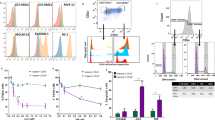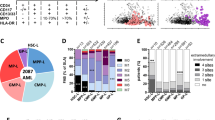Abstract
Acute myeloid leukemia (AML) cells exposed to genotoxic agents arrest their cell cycle at the G2/M checkpoint and are inherently chemoresistant. To understand the mechanism of this chemoresistance, we compared the ability of immature CD34+ versus mature CD34− AML cell lines (KG1a and U937, respectively) to recover from a DNA damage-induced cell cycle checkpoint in G2. Here, we report that KG1a cells have a more stringent G2/M checkpoint response than U937 cells. We show that in both cell types, the CDC25B phosphatase participates in the G2/M checkpoint recovery and that its expression is upregulated. Furthermore, we show that CHK1 inhibition by UCN-01 in immature KG1a cells allows checkpoint exit and induces sensitivity to genotoxic agents. Similarly, UCN-01 treatment potentializes genotoxic-induced inhibition of colony formation efficiency of primary leukemic cells from AML patients. Altogether, our results demonstrate that checkpoint stringency varies during the maturation process and indicate that targeting checkpoint mechanisms might represent an attractive therapeutic opportunity for chemoresistant immature AML cells.
This is a preview of subscription content, access via your institution
Access options
Subscribe to this journal
Receive 50 print issues and online access
$259.00 per year
only $5.18 per issue
Buy this article
- Purchase on Springer Link
- Instant access to full article PDF
Prices may be subject to local taxes which are calculated during checkout






Similar content being viewed by others
References
Amico D, Barbui AM, Erba E, Rambaldi A, Introna M, Golay J . (2003). Differential response of human acute myeloid leukemia cells to gemtuzumab ozogamicin in vitro: role of Chk1 and Chk2 phosphorylation and caspase 3. Blood 101: 4589–4597.
Bansal P, Lazo JS . (2007). Induction of Cdc25B regulates cell cycle resumption after genotoxic stress. Cancer Res 67: 3356–3363.
Bao S, Wu Q, McLendon RE, Hao Y, Shi Q, Hjelmeland AB et al. (2006). Glioma stem cells promote radioresistance by preferential activation of the DNA damage response. Nature 444: 756–760.
Bartek J, Lukas J . (2003). Chk1 and Chk2 kinases in checkpoint control and cancer. Cancer Cell 3: 421–429.
Bartek J, Lukas J . (2007). DNA damage checkpoints: from initiation to recovery or adaptation. Curr Opin Cell Biol 19: 238–245.
Blagosklonny MV . (2006). Target for cancer therapy: proliferating cells or stem cells. Leukemia 20: 385–391.
Bouquet F, Muller C, Salles B . (2006). The loss of gammaH2AX signal is a marker of DNA double strand breaks repair only at low levels of DNA damage. Cell Cycle 5: 1116–1122.
Boutros R, Dozier C, Ducommun B . (2006). The when and wheres of CDC25 phosphatases. Curr Opin Cell Biol 18: 185–191.
Brezak MC, Quaranta M, Contour-Galcera MO, Lavergne O, Mondesert O, Auvray P et al. (2005). Inhibition of human tumor cell growth in vivo by an orally bioavailable inhibitor of CDC25 phosphatases. Mol Cancer Ther 4: 1378–1387.
Bruno AP, Laurent G, Averbeck D, Demur C, Bonnet J, Bettaieb A et al. (1998). Lack of ceramide generation in TF-1 human myeloid leukemic cells resistant to ionizing radiation. Cell Death Differ 5: 172–182.
Bugler B, Quaranta M, Aressy B, Brezak MC, Prevost G, Ducommun B . (2006). Genotoxic-activated G2-M checkpoint exit is dependent on CDC25B phosphatase expression. Mol Cancer Ther 5: 1446–1451.
Chini CC, Chen J . (2003). Human claspin is required for replication checkpoint control. J Biol Chem 278: 30057–30062.
Chini CC, Chen J . (2006). Repeated phosphopeptide motifs in human Claspin are phosphorylated by Chk1 and mediate Claspin function. J Biol Chem 281: 33276–33282.
Chini CC, Wood J, Chen J . (2006). Chk1 is required to maintain claspin stability. Oncogene 25: 4165–4171.
Clarke CA, Clarke PR . (2005). DNA-dependent phosphorylation of Chk1 and Claspin in a human cell-free system. Biochem J 388: 705–712.
Clave E, Carosella ED, Gluckman E, Socie G . (1997). Radiation-enhanced expression of interferon-inducible genes in the KG1a primitive hematopoietic cell line. Leukemia 11: 114–119.
Dutertre S, Cazales M, Quaranta M, Froment C, Trabut V, Dozier C et al. (2004). Phosphorylation of CDC25B by Aurora-A at the centrosome contributes to the G2/M transition. J Cell Sci 117: 2523–2531.
Fernandez-Vidal A, Ysebaert L, Didier C, Betous R, De Toni F, Prade-Houdellier N et al. (2006). Cell adhesion regulates CDC25A expression and proliferation in acute myeloid leukemia. Cancer Res 66: 7128–7135.
Graves PR, Yu L, Schwarz JK, Gales J, Sausville EA, O'Connor PM et al. (2000). The Chk1 protein kinase and the Cdc25C regulatory pathways are targets of the anticancer agent UCN-01. J Biol Chem 275: 5600–5605.
Humbert O, Hermine T, Hernandez H, Bouget T, Selves J, Laurent G et al. (2002). Implication of protein kinase C in the regulation of DNA mismatch repair protein expression and function. J Biol Chem 277: 18061–18068.
Kramer A, Mailand N, Lukas C, Syljuasen RG, Wilkinson CJ, Nigg EA et al. (2004). Centrosome-associated Chk1 prevents premature activation of cyclin-B-Cdk1 kinase. Nat Cell Biol 6: 884–891.
Kumagai A, Dunphy WG . (2000). Claspin, a novel protein required for the activation of Chk1 during a DNA replication checkpoint response in Xenopus egg extracts. Mol Cell 6: 839–849.
Kumagai A, Kim SM, Dunphy WG . (2004). Claspin and the activated form of ATR-ATRIP collaborate in the activation of Chk1. J Biol Chem 279: 49599–49608.
Lindqvist A, Kallstrom H, Karlsson Rosenthal C . (2004). Characterisation of Cdc25B localisation and nuclear export during the cell cycle and in response to stress. J Cell Sci 117: 4979–4990.
Mailand N, Bekker-Jensen S, Bartek J, Lukas J . (2006). Destruction of Claspin by SCFbetaTrCP restrains Chk1 activation and facilitates recovery from genotoxic stress. Mol Cell 23: 307–318.
Mamely I, van Vugt MA, Smits VA, Semple JI, Lemmens B, Perrakis A et al. (2006). Polo-like kinase-1 controls proteasome-dependent degradation of Claspin during checkpoint recovery. Curr Biol 16: 1950–1955.
McManus KJ, Hendzel MJ . (2005). ATM-dependent DNA damage-independent mitotic phosphorylation of H2AX in normally growing mammalian cells. Mol Biol Cell 16: 5013–5025.
Nyberg KA, Michelson RJ, Putnam CW, Weinert TA . (2002). Toward maintaining the genome: DNA damage and replication checkpoints. Annu Rev Genet 36: 617–656.
Peschiaroli A, Dorrello NV, Guardavaccaro D, Venere M, Halazonetis T, Sherman NE et al. (2006). SCFbetaTrCP-mediated degradation of Claspin regulates recovery from the DNA replication checkpoint response. Mol Cell 23: 319–329.
Roberge M, Berlinck RG, Xu L, Anderson HJ, Lim LY, Curman D et al. (1998). High-throughput assay for G2 checkpoint inhibitors and identification of the structurally novel compound isogranulatimide. Cancer Res 58: 5701–5706.
Sampath D, Cortes J, Estrov Z, Du M, Shi Z, Andreeff M et al. (2006). Pharmacodynamics of cytarabine alone and in combination with 7-hydroxystaurosporine (UCN-01) in AML blasts in vitro and during a clinical trial. Blood 107: 2517–2524.
Schmitt E, Boutros R, Froment C, Monsarrat B, Ducommun B, Dozier C . (2006). CHK1 phosphorylates CDC25B during the cell cycle in the absence of DNA damage. J Cell Sci 119: 4269–4275.
Shiloh Y . (2003). ATM: ready, set, go. Cell Cycle 2: 116–117.
Smits VA, Medema RH . (2001). Checking out the G(2)/M transition. Biochim Biophys Acta 1519: 1–12.
Syljuasen RG, Jensen S, Bartek J, Lukas J . (2006). Adaptation to the ionizing radiation-induced G2 checkpoint occurs in human cells and depends on checkpoint kinase 1 and Polo-like kinase 1 kinases. Cancer Res 66: 10253–10257.
van Vugt MA, Bras A, Medema RH . (2004). Polo-like kinase-1 controls recovery from a G2 DNA damage-induced arrest in mammalian cells. Mol Cell 15: 799–811.
van Vugt MA, Medema RH . (2004). Checkpoint adaptation and recovery: back with Polo after the break. Cell Cycle 3: 1383–1386.
Warters RL, Barrows LR, Chen DJ . (1995). DNA double-strand break repair in two radiation-sensitive mouse mammary carcinoma cell lines. Mutat Res 336: 1–7.
Watanabe N, Arai H, Iwasaki J, Shiina M, Ogata K, Hunter T et al. (2005). Cyclin-dependent kinase (CDK) phosphorylation destabilizes somatic Wee1 via multiple pathways. Proc Natl Acad Sci USA 102: 11663–11668.
Xu B, Kim ST, Lim DS, Kastan MB . (2002). Two molecularly distinct G(2)/M checkpoints are induced by ionizing irradiation. Mol Cell Biol 22: 1049–1059.
Acknowledgements
We gratefully acknowledge R Boutros for corrections and comments on the manuscript. CD and CC are supported by a grant from the Institut National du Cancer (PL103). This work was also supported by CNRS, l'Université Paul Sabatier and la Ligue Nationale Contre le Cancer (Equipe labellisée 2005) grants to BD.
Author information
Authors and Affiliations
Corresponding author
Additional information
Supplementary Information accompanies the paper on the Oncogene website (http://www.nature.com/onc).
Rights and permissions
About this article
Cite this article
Didier, C., Cavelier, C., Quaranta, M. et al. G2/M checkpoint stringency is a key parameter in the sensitivity of AML cells to genotoxic stress. Oncogene 27, 3811–3820 (2008). https://doi.org/10.1038/sj.onc.1211041
Received:
Revised:
Accepted:
Published:
Issue Date:
DOI: https://doi.org/10.1038/sj.onc.1211041
Keywords
This article is cited by
-
Cytotoxic activity of the MK2 inhibitor CMPD1 in glioblastoma cells is independent of MK2
Cell Death Discovery (2015)
-
Over expression of hRad9 protein correlates with reduced chemosensitivity in breast cancer with administration of neoadjuvant chemotherapy
Scientific Reports (2014)
-
Pim kinases phosphorylate Chk1 and regulate its functions in acute myeloid leukemia
Leukemia (2014)
-
UCN-01 induces S and G2/M cell cycle arrest through the p53/p21waf1or CHK2/CDC25C pathways and can suppress invasion in human hepatoma cell lines
BMC Cancer (2013)
-
Roles of 14-3-3η in mitotic progression and its potential use as a therapeutic target for cancers
Oncogene (2013)



